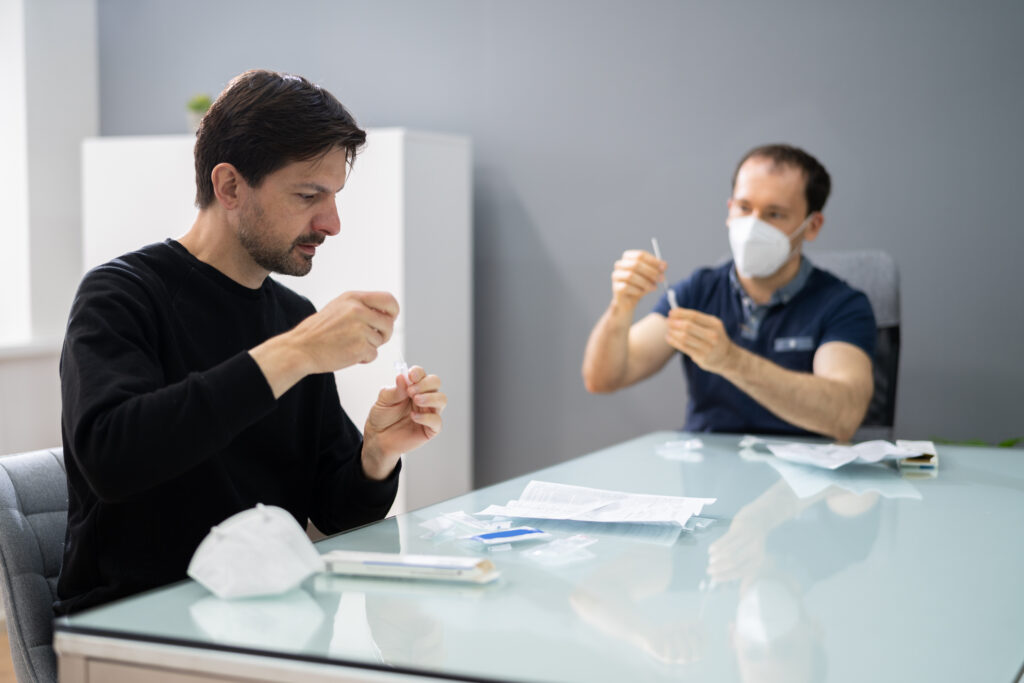For companies to avoid shutdowns and massive drops in productivity, continued employee COVID testing will be essential.
Public health officials are increasingly and cautiously confident that COVID-19 in the U.S. is transitioning from a pandemic to an endemic situation, a “deceleration” phase into a state of normalcy in which, experts hope, COVID-19 becomes manageable, similar to the seasonal flu.
But COVID-19 will not be eradicated, so employers have a vested interest and an obligation to protect the health of their employees with regular on-site rapid PCR testing. With uncertainty over how long immunity lasts and the virus’ trajectory of mutations, it will remain critically important for industries that rely on an in-person workforce – entertainment, hospitality, manufacturing, and others – to avoid expensive shutdowns and lost productivity by making testing accessible and convenient.
By lowering the barriers for employees – time, money, and access – employers can maintain the health of their workforce and reliability of productivity.
Why is COVID Testing Important?
As we experienced throughout 2020 and 2021, the productivity shocks from COVID-19 on contact-intensive industries impacted the entire global supply chain. Twenty-one per cent of the 31.4 percent drop in real GDP in the second quarter of 2020 can be attributed to COVID-19 impacts on contact-intensive industries, especially the travel and entertainment industries, and we continue to see the devastating ripple effects of that shock. Outbreaks affect staffing levels which leads to cancellations and shutdowns, and the interdependencies in the supply chain can cripple businesses that rely on these personal interactions. So on the business side of things, proactive measures enable businesses to assert more predictability into their short-term resource planning.
On the human side, as we slowly recover from these impacts and return to our “normal” lives and ways of doing business, we do so with heightened awareness that there are still many people at risk inside and outside our workplaces, including elderly and immunocompromised employees or their family members.
By taking appropriate preventive measures to detect outbreaks early, businesses can protect against lost productivity and reassure their employees that they are safe and valued when they come to work.
Related: COVID Rates in Key Areas Around the U.S.
Type of Companies that should keep testing
There are a handful of contact-intensive industries that were most impacted by COVID-19 losses and shutdowns: hospitality, air transportation, arts & entertainment, retail, food service and restaurants, manufacturing, education, and healthcare.
If you are a business owner and wondering whether or not to provide rapid on-site testing, ask this question: Do I have groups of employees working together in close proximity who also have interactions with others outside of the workplace? These groups are not a closed system. The only variables a business can control are inside the workplace – who you bring together and how. It makes sense, then, to ensure the safety of that work environment for everyone by implementing an ongoing testing protocol guided by current data about the local community virus levels.
For the film industry, where staff are likely moving from location to location individually or in groups, testing protects the group and the people they interact with in each of those communities.
Any contact-intensive business should be proactive in developing industry-specific protocols for on-site testing, infection management, and employee communication that maintains industry standards and protects individual privacy.
What to do if an employee tests positive for COVID?
If an employee tests positive at work, current CDC guidance is that employees should isolate themselves at home for 5 days and wear a KN95 or N95 mask for 10 days around others in public or around vulnerable friends and family. If they are fever-free after six days without medication, they can end isolation and return to work while continuing to wear a mask for another 4 days. They should be provided a private lunch area so that they are not around others while eating or drinking. During those 10 days, they should avoid travel, places where they cannot wear a mask, and being around high-risk individuals, both at work and outside of work.
Every employer can have a positive impact on the safety and health of their employees by communicating clearly about expectations for maintaining a safe workplace. Make sure employees know that they should not report to work if they are experiencing symptoms, and that if they do have symptoms, they should isolate to prevent transmission to others, get tested, and notify any close contacts at work and outside of work. A close contact is someone who was less than 6 feet away from the infected person for more than 15 minutes.
Moving Forward
While we’re not in full pandemic mode anymore, it may be a long time until COVID-19 is still not a major health and economic concern. Until then, and as we learn to live with its ongoing presence, it’s important to exercise caution and compassion, and to take the necessary steps to make sure we keep our lives — and our businesses — moving forward.
Interested in One Health Labs rapid PCR testing capabilities?
